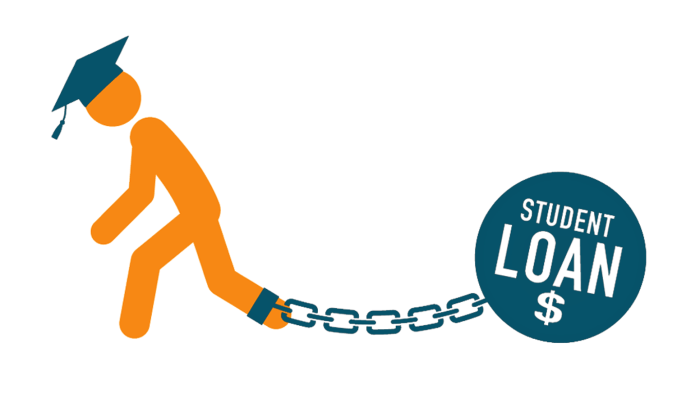
The crushing weight of student loan debt casts a long shadow over the lives of millions, impacting not only their finances but also their mental health, career choices, and overall well-being. This pervasive issue extends far beyond mere monetary concerns, influencing major life decisions and perpetuating socioeconomic disparities. Understanding the multifaceted effects of student loan debt is crucial to developing effective solutions and mitigating its far-reaching consequences.
From the emotional toll of constant repayment pressure to the limitations imposed on long-term financial planning, the burden of student loans significantly alters life trajectories. This exploration delves into the various ways student loan debt shapes individual experiences, from career aspirations to homeownership dreams, highlighting both the challenges and potential avenues for navigating this complex landscape.
The Psychological Impact of Student Loan Debt
The weight of significant student loan debt extends far beyond the financial burden; it significantly impacts the mental and emotional well-being of individuals. The constant pressure of repayment can lead to a cascade of negative consequences, affecting not only personal happiness but also relationships and overall life satisfaction. Understanding the psychological ramifications is crucial for developing effective coping strategies and support systems.
The stress of loan repayment frequently manifests as various mental health challenges. Anxiety and depression are common, stemming from the overwhelming feeling of being trapped in a cycle of debt. Individuals may experience difficulty sleeping, loss of appetite, or increased irritability. The constant worry about making payments can lead to a pervasive sense of hopelessness and negatively impact self-esteem, leading to feelings of failure and inadequacy. In some cases, the pressure can even contribute to more serious mental health conditions.
Stress and Relationships
The financial strain of student loan debt often spills over into personal relationships. Arguments about money can become frequent, creating tension and resentment between partners or family members. The stress of debt can lead to isolation and withdrawal, damaging close relationships. Individuals may postpone major life decisions, such as marriage, homeownership, or starting a family, due to financial concerns. This postponement can create further emotional strain and feelings of being “behind” their peers. For example, a couple might delay buying a house because of student loan repayments, leading to frustration and arguments.
Coping Mechanisms
Individuals employ various coping mechanisms to manage the psychological burden of student loan debt. Some focus on budgeting and financial planning, seeking to regain a sense of control over their finances. Others find solace in support groups or counseling, sharing their experiences and receiving emotional support. Exercise, mindfulness practices, and other stress-reduction techniques are also frequently used to manage anxiety and improve mental well-being. For instance, a person might start a meditation practice to manage their anxiety about loan repayments.
Support Systems and Resources
Several support systems and resources are available to help individuals address the mental health consequences of student loan debt. Financial counseling services can provide guidance on budgeting, debt management, and repayment strategies. Mental health professionals offer therapy and counseling to help individuals cope with the stress and anxiety associated with debt. Many universities and colleges also offer resources and workshops specifically designed to address the mental health needs of students facing financial challenges. Online communities and support groups provide a platform for individuals to connect with others facing similar situations, fostering a sense of community and shared understanding. For example, the National Alliance on Mental Illness (NAMI) offers resources and support for individuals struggling with mental health issues, including those related to financial stress.
Financial Implications of Student Loan Debt
Student loan debt casts a long shadow over many aspects of young adulthood and beyond, significantly impacting major financial decisions and long-term financial well-being. The weight of these loans can alter life trajectories, forcing difficult choices and potentially delaying or preventing the achievement of significant milestones.
Impact on Major Life Decisions
Student loan debt frequently delays or alters major life decisions such as homeownership, marriage, and starting a family. The substantial monthly payments required can reduce disposable income, making it challenging to save for a down payment on a house or to manage the expenses associated with marriage and raising children. For example, a couple burdened with significant student loan debt might postpone marriage until they can better manage their finances or choose a smaller, less expensive home to reduce their housing costs. The need to prioritize loan repayments can also influence the decision to have children, as the financial strain of raising a family is amplified by existing debt obligations. Many individuals find that they must delay these life events until their debt burden is lessened.
Effect on Saving for Retirement and Long-Term Financial Goals
The considerable monthly payments associated with student loan debt often leave little room for saving and investing in retirement accounts or other long-term financial goals. This can significantly impact future financial security, as individuals may find themselves behind in their retirement savings, leading to a potentially less comfortable retirement. For instance, someone with substantial student loan debt might be forced to contribute less to their 401(k) or IRA, hindering their ability to build a substantial nest egg for their later years. This can also affect other long-term goals, such as saving for a child’s education or purchasing a second home.
Comparison of Repayment Plans and Long-Term Implications
Different student loan repayment plans offer varying monthly payments and overall repayment periods. Standard repayment plans typically have higher monthly payments and shorter repayment terms, while income-driven repayment plans offer lower monthly payments but extend the repayment period, potentially leading to higher total interest paid over the life of the loan. For example, a standard repayment plan might require a higher monthly payment but allow for quicker debt elimination, while an income-driven plan offers a lower monthly payment but may lead to a significantly higher total interest paid over the longer repayment term. The choice of repayment plan significantly impacts the long-term financial consequences, requiring careful consideration of individual circumstances and financial goals.
Average Student Loan Debt and Monthly Payments
| Educational Level | Average Student Loan Debt | Average Monthly Payment (Standard Repayment) | Average Monthly Payment (Income-Driven Repayment – Estimated) |
|---|---|---|---|
| Associate’s Degree | $20,000 | $300 | $150 |
| Bachelor’s Degree | $37,000 | $550 | $275 |
| Master’s Degree | $70,000 | $1000 | $500 |
| Professional Degree (e.g., Law, Medicine) | $150,000 | $2200 | $1100 |
*Note: These figures are averages and can vary significantly based on individual loan terms, interest rates, and repayment plan chosen. These are illustrative examples and may not reflect current averages precisely. Consult official sources for the most up-to-date information.*
Impact on Career Choices and Opportunities

The weight of student loan debt significantly impacts the career paths individuals choose and the opportunities they pursue. The financial burden often necessitates prioritizing immediate financial stability over long-term career aspirations, leading to decisions that may not fully align with personal passions or goals. This influence extends beyond simple job selection, impacting risk tolerance and entrepreneurial endeavors.
Student loan debt frequently compels graduates to prioritize higher-paying jobs, even if those jobs are less fulfilling or align less closely with their interests. The pressure to quickly repay loans can override the desire to pursue a passion project or a less lucrative but more personally rewarding career. This often translates into a trade-off between financial security and personal satisfaction, a difficult choice many recent graduates face.
Career Choices and Debt Levels
The correlation between student loan debt and career choices is demonstrably strong. Individuals burdened with significant debt are more likely to select stable, high-paying positions, even if those positions are not ideal. For example, a graduate with a passion for environmental science might instead accept a higher-paying role in finance to expedite loan repayment, foregoing their initial career aspirations. Conversely, graduates with minimal or no debt are more likely to pursue less lucrative but fulfilling careers, such as teaching or the arts, allowing them greater freedom to prioritize personal fulfillment. This disparity in career trajectories highlights the significant influence of financial constraints on life choices.
Entrepreneurial Pursuits and Risk Aversion
Starting a business requires significant financial investment and often involves a period of uncertainty before profitability is achieved. The presence of substantial student loan debt significantly increases the risk associated with entrepreneurship. Individuals with high debt levels are less likely to take the leap into self-employment due to the financial vulnerability it presents. The fear of loan default further discourages entrepreneurial pursuits, as the failure of a new business could exacerbate an already precarious financial situation. Conversely, individuals without significant debt are better positioned to tolerate the risks associated with starting a business, allowing them to pursue innovative ideas and entrepreneurial ventures with greater freedom.
Strategies for Managing Debt While Pursuing Desired Careers
Managing student loan debt while pursuing a desired career path requires careful planning and strategic decision-making. One effective approach is to explore repayment options, such as income-driven repayment plans, which adjust monthly payments based on income. Another strategy involves budgeting meticulously and prioritizing debt reduction. Graduates should also actively seek out career opportunities that offer both financial stability and personal fulfillment. This might involve networking strategically, pursuing further education or training to enhance career prospects, and considering part-time or freelance work to supplement income while pursuing a long-term career goal. Finally, open communication with loan servicers is crucial to explore options and avoid potential defaults.
Geographic and Socioeconomic Disparities

The burden of student loan debt is not evenly distributed across the population. Significant disparities exist based on race, income level, and geographic location, creating a complex web of interconnected challenges for borrowers facing financial hardship. These disparities exacerbate existing inequalities and hinder upward mobility for many individuals. Understanding these differences is crucial for developing effective solutions to address the student loan crisis.
The weight of student loan debt disproportionately affects specific demographic groups and regions, creating significant inequities in access to higher education and subsequent financial well-being. This section will explore these disparities in detail.
Racial and Ethnic Disparities in Student Loan Debt
Black and Hispanic borrowers consistently carry higher levels of student loan debt compared to their white counterparts, even when controlling for factors like educational attainment and income. This disparity is largely attributed to systemic inequalities in access to quality education, wealth accumulation, and financial resources. For example, Black students are more likely to attend for-profit institutions with higher tuition costs and lower graduation rates, leading to greater debt accumulation without the same return on investment. Furthermore, the historical legacy of discriminatory practices in housing, employment, and wealth accumulation has left many minority communities with fewer resources to support higher education costs. This persistent wealth gap directly translates to a greater reliance on student loans and a more challenging path to repayment.
Geographic Disparities in Access to Debt Management Resources
Access to resources and support for managing student loan debt varies significantly across geographic locations. Rural areas often lack the same level of financial literacy programs, credit counseling services, and legal aid as urban centers. This disparity limits borrowers’ ability to navigate complex repayment options, explore debt relief programs, and effectively manage their debt. For instance, individuals in rural areas may have limited access to internet connectivity, making it difficult to access online resources and apply for federal assistance programs. The scarcity of financial professionals specializing in student loan debt management further compounds the issue in these underserved regions.
Socioeconomic Background and Access to Higher Education
Socioeconomic background significantly impacts access to higher education and the subsequent burden of student loan debt. Students from low-income families are often forced to rely more heavily on loans to finance their education, as they have less access to family savings, grants, and scholarships. This increased reliance on borrowing can lead to significantly higher debt loads, making repayment a much more daunting task. Furthermore, students from disadvantaged backgrounds may face additional challenges, such as limited access to quality K-12 education, which can impact their college preparedness and increase their likelihood of needing remedial courses, delaying graduation and increasing overall costs. The cumulative effect of these factors creates a cycle of debt that can be difficult to break.
Key Disparities in Access to Education and Debt Management Resources
- Racial/Ethnic Disparities: Minority borrowers, particularly Black and Hispanic individuals, often carry significantly higher student loan debt than white borrowers, even with similar educational attainment.
- Income Disparities: Low-income borrowers are more reliant on loans and face greater challenges in repayment due to limited access to alternative funding sources.
- Geographic Disparities: Access to debt management resources, including financial literacy programs and legal aid, is significantly lower in rural areas compared to urban centers.
- Access to Higher Education: Socioeconomic background profoundly impacts access to quality K-12 education, college preparation resources, and financial aid, ultimately affecting the amount of debt accumulated.
Long-Term Economic Consequences
The accumulation of substantial student loan debt carries significant long-term consequences for individuals and the national economy. These effects ripple outwards, impacting various sectors and hindering overall economic growth. The sheer scale of this debt presents a systemic risk that demands careful consideration.
Student loan debt significantly hinders economic growth and reduces consumer spending. Individuals burdened by large loan repayments have less disposable income to allocate towards other economic activities such as purchasing homes, investing in businesses, or spending on goods and services. This reduced consumer demand weakens economic activity, creating a drag on overall growth. For example, a young professional with $100,000 in student loan debt might delay purchasing a home or starting a family, directly impacting related industries like real estate and childcare. The money they would have spent is instead directed towards loan repayment, reducing the overall economic circulation.
Impact on Consumer Spending and Investment
The considerable monthly payments associated with student loans directly constrain discretionary spending. This decreased consumer spending can lead to reduced economic activity across various sectors, from retail to hospitality. Furthermore, the weight of student loan debt often discourages individuals from making significant investments, such as starting a business or purchasing a home. This hesitancy to take financial risks can stifle entrepreneurial activity and limit economic expansion. Imagine a young entrepreneur with substantial student loan debt: the risk associated with starting a business, coupled with the pressure of loan repayments, might dissuade them from pursuing their venture, potentially losing out on future economic contributions.
Ripple Effects on the National Economy
Widespread student loan debt creates a domino effect across the national economy. Reduced consumer spending translates into lower overall demand, potentially leading to slower job growth and reduced business investment. The strain on personal finances also contributes to increased financial stress and potential defaults, impacting lending institutions and the overall financial stability of the nation. A scenario where a large portion of the population struggles with significant debt repayments can significantly hinder the overall economic performance of a nation, slowing its growth trajectory.
Impact on Housing Market and Economic Indicators
Student loan debt has a demonstrably negative impact on the housing market. High loan repayments reduce the affordability of homeownership, particularly for younger generations. This reduced demand can lead to lower house prices and reduced construction activity, affecting related industries. Furthermore, high levels of student loan debt are associated with lower rates of homeownership and negatively affect other major economic indicators, such as GDP growth and savings rates. For instance, a significant increase in student loan defaults can trigger a ripple effect, impacting credit ratings and potentially leading to a credit crunch, further dampening economic activity.
Long-Term Economic Implications of High Student Loan Debt
A persistent high level of student loan debt creates a long-term drag on the economy. It reduces aggregate demand, stifles entrepreneurship, and limits economic mobility. The accumulated debt acts as a persistent weight on economic growth, potentially leading to slower wage growth, reduced investment, and a diminished standard of living for many. Imagine a future where a significant portion of the workforce is perpetually burdened by student loan debt; their reduced spending power and limited investment capacity would inevitably result in a less dynamic and prosperous economy. This scenario would also impact future generations, potentially creating a cycle of debt and economic stagnation.
Closing Summary

In conclusion, the impact of student loan debt is a multifaceted problem with profound consequences across various aspects of life. Addressing this issue requires a comprehensive approach that considers the psychological, financial, and societal implications. By acknowledging the significant challenges and exploring innovative solutions, we can work towards a future where higher education does not come at the cost of long-term financial stability and personal well-being.
FAQ Guide
What are some common signs of student loan debt stress?
Common signs include anxiety, depression, sleep disturbances, strained relationships, and difficulty concentrating.
Can I consolidate my student loans?
Yes, consolidating multiple loans into one can simplify repayment, potentially lowering your monthly payment. However, it may extend the repayment period and increase overall interest paid.
What happens if I default on my student loans?
Defaulting can lead to wage garnishment, tax refund offset, and damage to your credit score, making it difficult to obtain loans or credit in the future.
Are there any government programs to help with student loan repayment?
Yes, programs like income-driven repayment plans and loan forgiveness programs for certain professions exist. Eligibility criteria vary.
